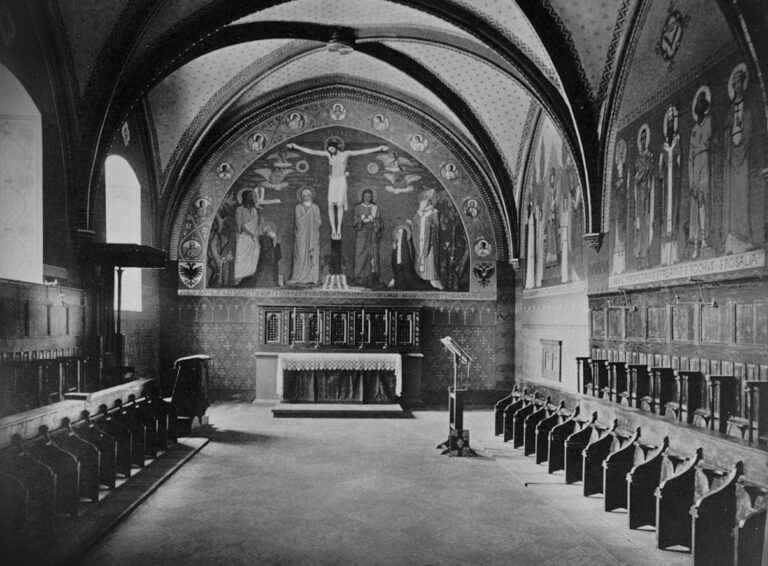Imperial Chapel
Compared to the church monumental space intended for public and solemn liturgy, the chapel has always been a more private, secret place used for prayers by the monastic community.
This is perhaps why the chapel has a distinctive spiritual atmosphere, supported by relatively well-preserved decoration from the 1880s. In the early days of monastery construction, the entire eastern wing was occupied by a long hall, accessible from the cloister. An archaeological research uncovered the original hall entrance in the 1960s, with a lining painted in fresh colors, giving the evidence of the entrance short use. In the next phase, the hall was partitioned and the portal to the cloister was walled up.
The mural which originated at that time, no longer exists today. It was dominated by the scenes of the Nailing to the Cross, the Crucifixion, the Piercing of Christ's side and the Descent into Hell, accompanied by Old Testament parables. These scenes represented the culminating scenes of the Emmaus cycle. It was not clear for a long time why they were missing on the cloister walls until the discovery of the entire cycle description in the so-called Uppsala manuscript, in the beginning of the 15th century that solved the mystery. In 1636, the Benedictines of Montserrat separated the chapel from the church with a narthex and built a monumental portal announcing its dedication to the plague patron saints.
...you can travel back through time by swiping
 HISTORY
HISTORY
 PRESENT
PRESENT
Did you know that...?
During Charles IV time, a part of the so-called Imperial Regalia was probably kept in the chapel. Charles IV acquired the regalia in 1350. In addition to the crown jewels, the ceremonial sword, cloak and other valuables, it included the relics related to Christ's crucifixion: spikes and a spear that pierced Christ's side. After his coronation as Roman Emperor, Charles IV introduced the annual feast day of the Lord’s Spear and Spikes to venerate these relics. The main celebration involving the display of the relics took place in today's Charles Square; they could then be venerated privately in the Imperial Chapel.
The Imperial Regalia had a colorful fate: during the Hussite storms it was taken out of Bohemia and stored in Nuremberg. In 1796, fearing the advancing Napoleonic army, the Nuremberg councilors entrusted it to the Habsburgs who took it to Vienna. It remained there after the formal dissolution of the Holy Roman Empire in 1806. In the 1930s, it cought attention of the Nazis. Adolf Hitler’s occult inclinations are known. He believed not only in the imperial symbolism associated with Lord’s spear, but also in its actual magical power to ensure the victory of German arms. So he had the regalia taken to Nuremberg. After the end of the World War II, the Americans returned the Imperial Regalia to Austria, where they became part of the Imperial Treasury exhibit in the Hofburg Palace.


